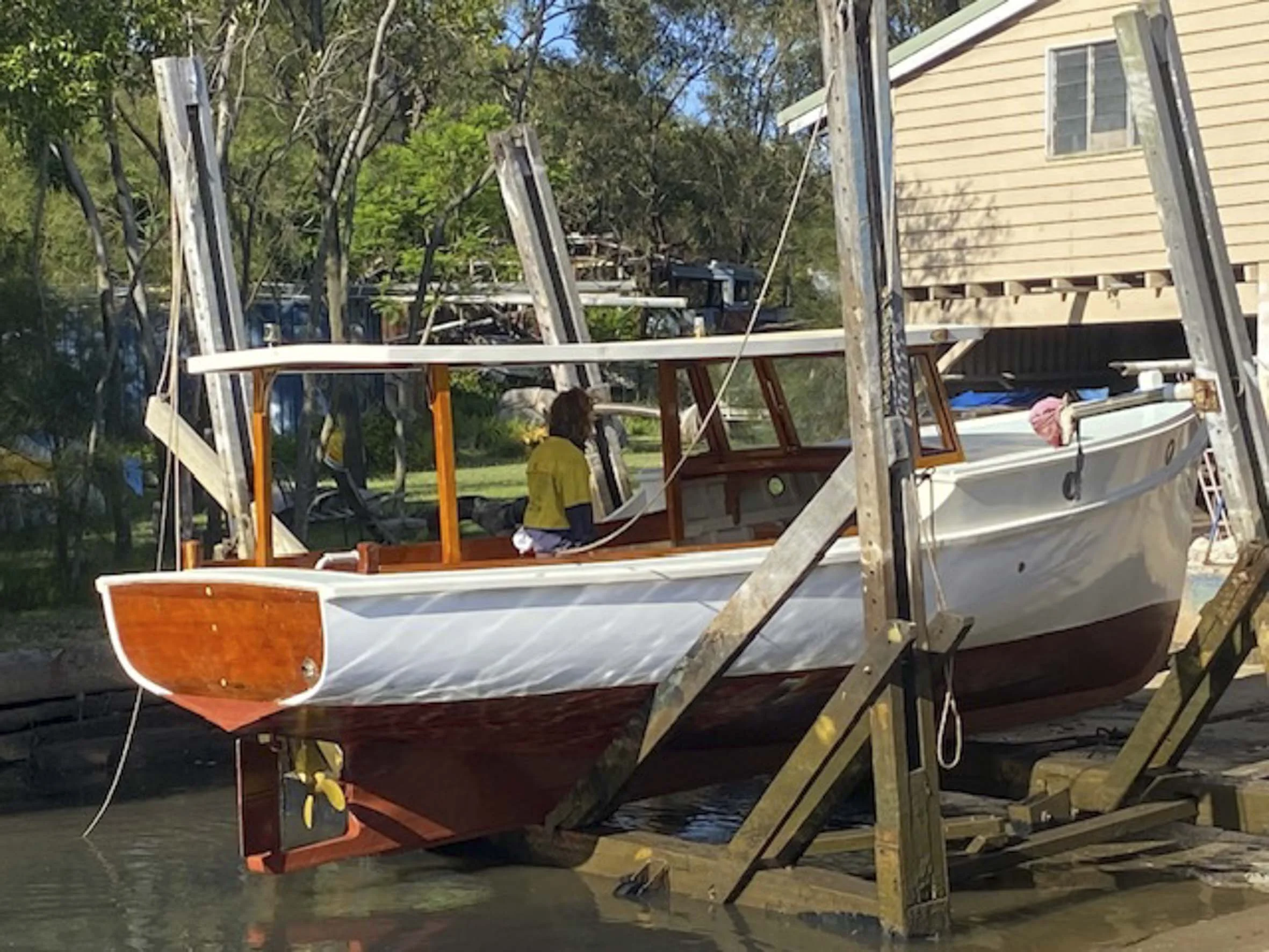The Big Question-Restore, Renovate or Re-birth
By Craig Coulsen
ROSIE’s relaunch
For every ten people who buy an old timber boat with a vision and dreams of restoration, I would be betting only one of the ten ever answers the big question at the time.
“What am I trying to achieve here and what do I really need from the boat?”
And only the new owner will know that answer.
It is not a “want” issue but a “need” issue and few I wager will be completely honest about this at the time of purchase. But let’s not to be too hard, the answer sometimes comes after a time.
So here is the story of ROSIE to question what each new owner may wish to achieve.
ROSIE is a Fisher built Sydney Harbour Snapper boat. The snapper boats were a common sight even into the 1970s. Whether you got a Fisher built boat or a Marks built boat did not matter much as some were built by both families together. The construction method was generally the same and the length of the finished boat depended on the length of the full-length planks delivered from the mill.
ROSIE, it seems may have been built by a member of the Fisher family at Camden Haven on commission in the early 1960s. In any event the hardy little boats were put to many uses so while lightly framed, a good hardwood keelson and excellent planking seemed to ensure longevity.
Marks family beam trawler. (photo courtesy of Dean Marks)
A move to a weekend house a few years back gave rise to the question of what boat does the family need, not want, to use on the adjacent estuary. About then ROSIE appeared in the boat advertisements and over the next few months Rosie remained unsold and remained a possible answer. Eventually a deal was done and another timber boat entered the home fleet.
ROSIE when purchased
After a quick antifoul and topside brush on the way home from the Gold Coast, Rosie began duties trolling for pelagic fish in the northern end of Moreton Bay and doing lunch runs to a nearby waterfront pub. Then one day ROSIE got slammed against the dock by the wash of large “white boat” doing about 12 knots in a canal with the result many seams above the waterline on the port side had opened up. At rest it was fine but underway it was getting unsafe. So, the question was recaulk or replace the ill-fitting bastard plank which was where the hull was most damaged or go all out.
The hull was a great design otherwise well-built and for estuary cruising and fishing, the boat was ideal.
And beside everyone loved the boat. But what do we do? Restore to an original 1960 fishing boat, renovate making the boat new and reflecting modern misplaced wants?
Or a re-birth, taking the best of the original, rejecting unnecessary modernity but remain true to want you need the boat to do. So, what were the needs and the vision?
For ROSIE, it was a disciplined re-birth, staying true to the work boat heritage while been ruthlessly honest about how the boat would be used as a day boat. So, no bunks, no full galley, plenty of seats and for Queensland, plenty of shade. About this there could be no compromise, and the re-birth brutally began.
Stripped interior
Along the way decisions were made to ensure an even longer life for ROSIE, seams were splined, deck beams replaced and a wonderful cold moulded two- ply roof made. As with any wooden boat restoration there is the unexpected, but this was a real good one. A day after splining, a once in 200-year flood puts eight foot of water through the shed. ROSIE floated off the stands, hit the roof of the shed and came down to rest against the side of the shed, which otherwise prevented Rosie washing away never to be seen again. The result is zero damage and about a quarter of a bucket of water in the bilge. Some boats are just lucky. The shed was however a disaster zone and out of action for the best part of three months.
ROSIE against side of shed
There is a lot to be said for perspective and having ROSIE on the side of the shed meant you could stand back and have a good look at the countless mock ups of the coach house and roof.
Windscreen mock up
So back to the big question, the look had to vintage and showing off the rare timber sourced for the job, but the end result could not be too “Bristol” as ROSIE was originally a work boat.
Queensland maple cockpit coaming
Grown mangrove knee
The cockpit layout consistent with the work boat ethos is long bench seats of Queensland Oregon while the planked floor is reclaimed kauri from a cut up 38 footer hence all the plugs in the floor planking. The decision was made to leave it all raw finish.
Cockpit with Oregon seats and reclaimed kauri floor
Galley bench
On the other hand, as a day boat, the timber panelling hides a full-size electric loo and holding tank and the galley bench is ready for afternoon tea. (fridge cover not fitted)
Bribie Classic Boat Rally-Photo Peter McNamara
So back to the big question, what was sought to be achieved here? ROSIE was always to be day boat but a beautiful one that did not betray the work boat origins. Sure, ROSIE no longer looks like a true working boat but there is not a line on the boat that should be changed.
And you can’t do better than that. But at the same time, the flat panel windscreen, the beautiful, curved roof and subtle multi-tone paint scheme are not of the modern era. So not a restoration as a period piece or a renovation to modernity but a re-birth into another life.
ROSIE is not what ROSIE was, but this ROSIE is ROSIE for now.
Acknowledgement to Peter Kerr at Deagon Slipway along with Josh, Mona and Tom. Another great collaboration to achieve something beautiful















